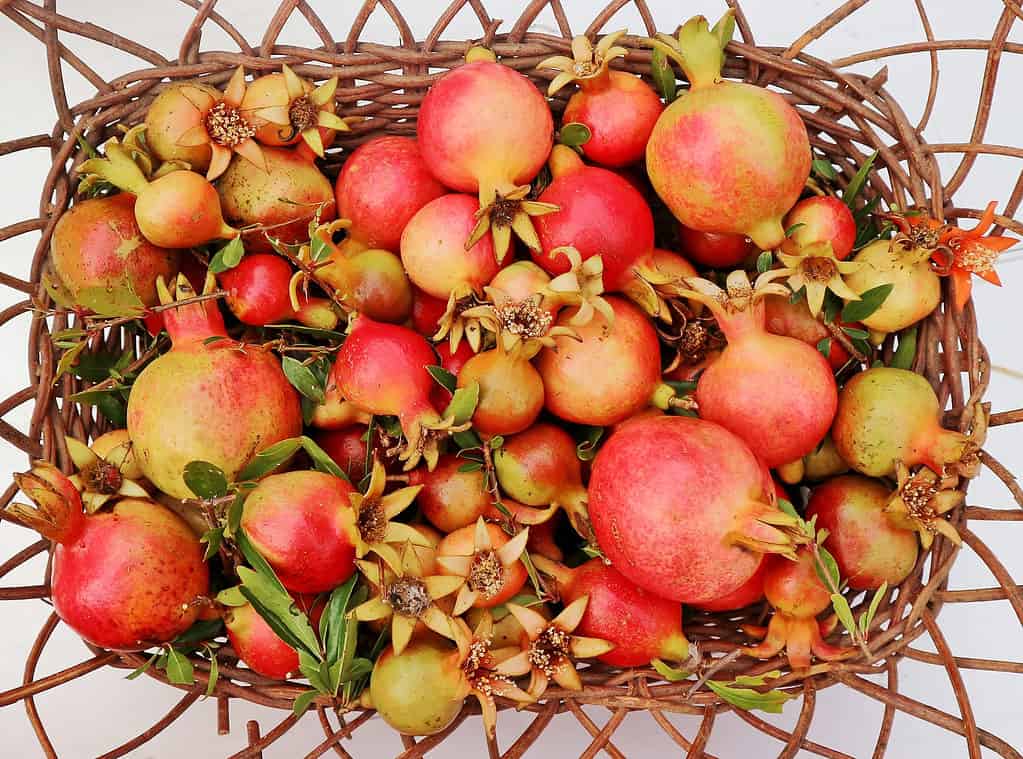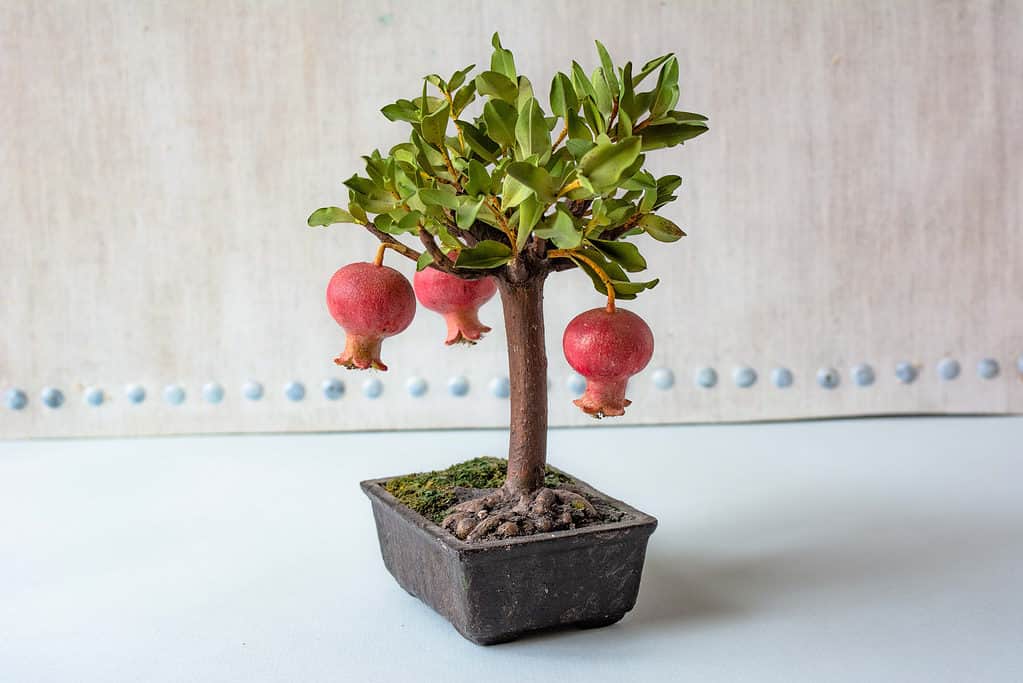Pomegranates are delightful. This fruit is known for its vibrant ruby-red seeds and sweet-tart flavor. The pomegranate is native to Iran and the Himalayas. But now, they are widely cultivated in various regions across the United States. That means… if you’re a fan of this exotic fruit, it’s easier to get now more than ever. But to truly enjoy your pomegranate experience, you want to ensure your tasty treat is in season. Understanding which regions or growing areas grow pomegranates and when, will help you select the best fruit. Keep reading to discover when pomegranates are in peak season across the U.S., and get some tips for enjoying them once you buy.
What Are Pomegranates?
Before we dive into a specific discussion about growing regions, you may be wondering what exactly pomegranates are. And that’s a great question! This delicious fruit is not one of the more well-known fruits in the United States. However, it is growing in popularity year after year.
They are large, typically red, fruit about the size of a grapefruit. The skin feels hard and sometimes rough, so it is easy to wonder how you would eat it. And the truth is, you don’t. What gets eaten is the pulp that surrounds the seeds inside. This pulp ranges between bright red and dark red. Its flavor is simultaneously sweet and a bit tart. Some people suck the pulp away from the seeds before discarding them. But the seeds themselves are edible, so you don’t have to worry.
While most people refer to pomegranate trees, they actually grow on shrubs. They’re just large shrubs. And that means they can grow in nearly any area that has a favorable climate.

Pomegranates are a mostly red-colored fruit with a hard outer shell. Once you crack one open, you discover a sweet, and slightly tart, internal pulp.
©luca pbl/Shutterstock.com
Where Do Pomegranates Grow?
California
It should come as no surprise that the weather of California is the perfect spot for pomegranate production. In fact, the state grows almost 100% of the country’s stock!
The primary pomegranate-growing regions in California include the San Joaquin Valley, Coachella Valley, and Central Valley. Each of these spots provides a more Mediterranean-like climate, with hot, dry summers and mild winters. And that helps pomegranates thrive.
Pomegranate trees in California typically begin to flower in late spring, around May. The fruits then develop and grow throughout the summer months. The peak ripening period occurs between August and November or December, depending on the weather. It’s during this period that you’ll find the best selection of fresh, juicy pomegranates in grocery stores and farmers’ markets across the country.
Arizona
While Arizona has some catching up to do, in recent years, it has emerged as a notable pomegranate-growing state. The warm climate and well-draining soils in the region create favorable conditions for pomegranate orchards.
Pomegranate cultivation in Arizona closely follows the schedule in California, though the peak season starts slightly later. The flowering begins in late spring, and the peak harvesting season falls between October and December.
Texas
Texas is another state that is trying to dip its proverbial toe in the pomegranate industry. Southern, southeastern, and central Texas are all well-known for their pomegranate orchards.
Peak pomegranate season in Texas really depends on the weather. Some years, the harvest starts as early as August. But for others, you may have to wait until October. Either way, if you’re in Texas or the neighboring states, you can indulge in fresh pomegranates as autumn sets in.
Other Growing Regions
Pomegranates historically grow well in the region that is modern-day India and Iran, though they also spread into the Mediterranean region. These days, pomegranate orchards are still very common in those areas. However, they have also gained popularity in the Americas. You may encounter pomegranate trees throughout the warmer locations that run from the United States all the way down to Chile.
Can You Grow Pomegranates at Home?
Yes, you absolutely can! Well, with one caveat. You need to live in USDA Hardiness Zones 8-10. And you need to leave enough room for it. The trees can grow well over 12 feet high. However, typically they only reach 6 to 12 feet. They have orange-red flowers and bright green leaves, adding spectacular visual appeal to any garden area.
This deciduous shrub needs full sun, thrives in the heat, and is relatively drought-tolerant. You can pick up a small tree from a local nursery. After you get it established where you want it, feed it the occasional round of nitrogen fertilizer to keep it happy. They are a fairly low-maintenance plant overall once you get started.

This dwarf pomegranate bonsai tree highlights how easy it could be to grow at home. You don’t even need a huge plot of land.
©Fanni_2021/Shutterstock.com
What Are the Health Benefits of Pomegranates?
Pomegranates are more than just a flavorful treat; they are a nutrient powerhouse packed with essential vitamins, minerals, and antioxidants. Here are some of the incredible health benefits of consuming pomegranates:
Probably its top claim to fame is its high antioxidant levels. There are actually nearly three times more antioxidants in pomegranates than in green tea!
They also have heart-protective polyphenol compounds — punicalagins, ellagitannins, anthocyanins, and anthoxanthins. So you can enjoy your pomegranates knowing that it is a heart-healthy menu option.
And finally, they are a fantastic source of flavonoids, fiber, Vitamin C, and potassium. You can’t really go wrong eating one of these.
Perhaps the only downside, but one that everyone should be aware of, is that a small number of people are allergic to pomegranates. So, if you have any known allergies or any concerns, you should consult a physician before eating them.

Pomegranates are a nutrient powerhouse packed with essential vitamins, minerals, and antioxidants.
©Nazaruk Nazar/Shutterstock.com
How Do You Eat Pomegranates?
While snacking on fresh pomegranate seeds is a delightful experience in itself, there are various other ways to incorporate this superfood into your diet. Here are just a select few options.
Juice
Freshly squeezed pomegranate juice is a refreshing and nutritious beverage that retains many of the fruit’s health benefits. You can get it by removing the pulp and the seeds and pressing it. However, that is time-consuming, and most people don’t have the proper equipment. So feel free to pick some up at the store!
Smoothies
Add the seeds or juice to your favorite smoothie recipes for a burst of color, flavor, and nutrition.
Salad Dressing
Salad dressing is probably a vastly underrated way to enjoy pomegranates. Simply blend the juice with olive oil, honey, and a touch of vinegar for a tangy and healthy salad dressing.
Pomegranate Molasses
Producing this delicious treat is easy. All it takes is time. Reduce the juice to a thick, sweet-tart syrup over a low temperature. It can then get drizzled over desserts or used in savory dishes. (They also sell this in some stores).
Pomegranate Salsa
Move aside mango salsa; there’s a new fruit in town! Pomegranate salsa is a surprisingly refreshing dish. Combine diced seeds with tomatoes, onions, cilantro, and lime juice for a unique twist.
Pomegranate Guacamole
Don’t stop at the salsa! Add some seeds to your guacamole for an extra burst of flavor and texture.
Pomegranate Yogurt Parfait
Layer the flavorful seeds with Greek yogurt and granola for a nutritious and colorful breakfast or dessert.
Add to Meat
Surprisingly, the tart flavor of pomegranates goes quite well with grilled or roasted meats.
Make a Marinade
If you can handle a slightly sweet marinade, why not try this version next time? With a slight added tart flavor, this marinade will work well on meat and tofu dishes.
The photo featured at the top of this post is © iStock.com/Emma Grimberg
Thank you for reading! Have some feedback for us? Contact the AZ Animals editorial team.







